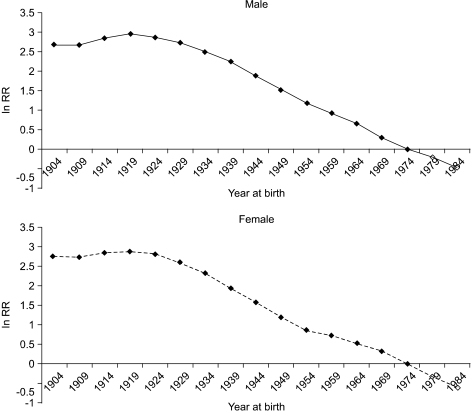Cancer Res Treat.
2006 Feb;38(1):7-12.
Long Term Trends and the Future Gastric Cancer Mortality in Korea : 1983~2013
- Affiliations
-
- 1Department of Preventive Medicine, Seoul National University College of Medicine, Seoul, Korea. kyyoo@plaza.snu.ac.kr
Abstract
- PURPOSE
In spite of gastric cancer's decreasing incidence and mortality rates, it is still the most common cancer in Korea. In the present study, we examined the temporal trends of gastric cancer mortality during the past 20 years in Korea by using an age-period-cohort model, and we predicted the mortality rates for the next 10 years.
MATERIALS AND METHODS
Data on the annual number of deaths due to gastric cancer and data on population statistics from 1984 to 2003 were obtained from the Korean National Statistical Office. A log-linear Poisson ageperiod-cohort model was used to estimate age, period and birth cohort effects. To project two periods (10 years) into the future, the new cohort values were estimated by performing linear regression that was applied to a chosen number of the most recent cohort values.
RESULTS
The trends of gastric cancer mortality were predominantly explained by the cohort effect; the risk of gastric cancer death decreased since the 1919 birth cohort for both genders. The predicted, expected age-adjusted mortality rates per 100,000 for males and females are 45.72 and 23.75, respectively, during 2004~2008, and 34.62 and 17.93 respectively, during 2009~2013. During 2004~2008 and 2009~2013, the predicted numbers of deaths due to gastric cancer in males are 36,922 and 27,959, respectively, whereas those in females are 19,698 and 14,869, respectively.
CONCLUSIONS
Not only the mortality, but also the incidence of gastric cancer in Korea is expected to further decrease in both men and women if the trends of the past 20 years continue.
Keyword
MeSH Terms
Figure
Reference
-
1. Ministry of Health and Welfare republic of Korea, Korea Central Cancer Registry, Local Cancer Registries. Cancer incidence in Korea 1999~2001. 2005. Gwacheon-city, Korea: Ministry of Health and Welfare Republic of Korea.2. Ministry of Health and Welfare republic of Korea. Available from: URL:http://www.nso.go.kr.3. Lee HJ, Yang HK, Ahn YO. Gastric cancer in Korea. Gastric Cancer. 2002; 5:177–182. PMID: 12378346.
Article4. Holford TR, Roush GC, Mckay LA. Trends in female breast cancer in Connecticut and the United States. J Clin Epidemiol. 1991; 44:29–39. PMID: 1986055.
Article5. Osmond C. Using age, period and cohort models to estimate future mortality rates. Int J Epidemiol. 1985; 14:124–129. PMID: 3988427.
Article6. Ahn YO. Diet and stomach cancer in Korea. Int J Cancer. 1997; 10(Suppl):7–9. PMID: 9209012.
Article7. Kim HJ, Chang WK, Kim MK, Lee SS, Choi BY. Dietary factors and gastric cancer in Korea: a case-control study. Int J Cancer. 2002; 97:531–535. PMID: 11802218.
Article8. The food supply and demand table in 2004. Korean rural economic institute. Available from: URL:http://www.krei.re.kr/issue/report_list.php.9. Gwack J, Choi Y, Shin HR, Hong YC, Yoo KY. Long-termprediction of gastric cancer mortality in Korea. Korean J Epidemiol. 2005; 27:163–172.10. Hwang H, Dwyer J, Russell RM. Diet, Helicobacter pylori infection, food preservation and gastric cancer risk: are there new roles for preventive factors? Nutr Rev. 1994; 52:75–83. PMID: 8015750.11. Jee SH, Samet JM, Ohrr H, Kim JH, Kim IS. Smoking and cancer risk in Korean men and women. Cancer Causes Control. 2004; 15:341–348. PMID: 15141135.
Article12. Laheij RJ, Straatman H, Verbeek AL, Jansen JB. Mortality trend from cancer of the gastric cardia in the Netherlands, 1969~1994. Int J Epidemiol. 1999; 28:391–395. PMID: 10405839.
Article13. Kim N. Epidemiology and transmission route of Helicobacter pylori infection. Korean J Gastroenterol. 2005; 46:153–158. PMID: 16179833.14. Kim JP, Park JG. Results of treatment of stomach cancer. J Korean Med Assoc. 1983; 26:637–642.15. Kim SC, Hur YS, Kim JP. Prognostic factors in early gastric cancer. J Korean Cancer Assoc. 1994; 26:1–8.16. Kim YS, Park HA, Kim BS, Yook JH, Lee MS. Efficacy of screening for gastric cancer in a Korean adult population: a case-control study. J Korean Med Sci. 2000; 15:510–515. PMID: 11068986.
Article17. Oshima A, Hirata N, Ubukata T, Umeda K, Fujimoto I. Evaluation of a mass screening program for stomach cancer with a case-control study design. Int J Cancer. 1986; 38:829–833. PMID: 3793262.
Article18. Fukao A, Tsubono Y, Tsuji I, Hisamichi S, Sugahara N, Takano A. The evaluation of screening for gastric cancer in Miyagi Prefecture, Japan: a population-based case-control study. Int J Cancer. 1995; 60:45–48. PMID: 7814150.
Article19. Jo MW, Khang YH, Yun S, Lee JY, Lee MS, Lee SI. Proportion of death certificates issued by physicians and associated factors in Korea, 1990~2002. J Prev Med Pub Health. 2004; 37:345–352.20. Chie WC, Chen CF, Lee WC, Chen CJ, Lin RS. Age-period-cohort analysis of breast cancer mortality. Anticancer Res. 1995; 15:511–515. PMID: 7763032.
- Full Text Links
- Actions
-
Cited
- CITED
-
- Close
- Share
- Similar articles
-
- Correction: Long Term Trends and the Future Gastric Cancer Mortality in Korea: 1983~2013
- Long-term prediction of gastric cancer mortality in Korea
- Forecasting Cause-Specific Mortality in Korea up to Year 2032
- Epidemiology of Gastric Cancer in Korea: Trends in Incidence and Survival Based on Korea Central Cancer Registry Data (1999–2019)
- Laparoscopic Surgery for Gastric Cancer


